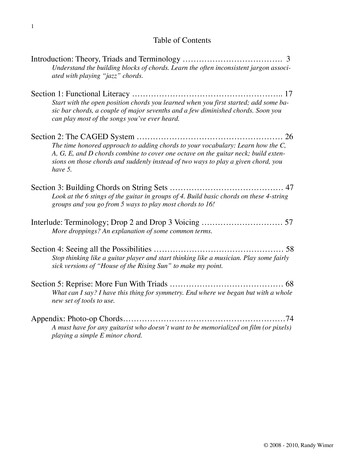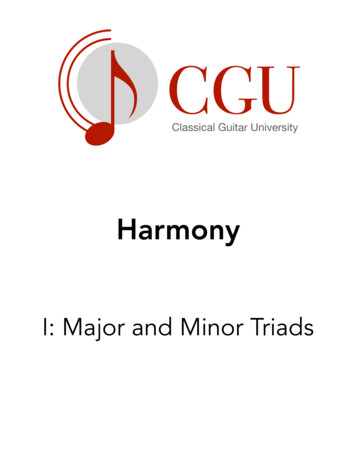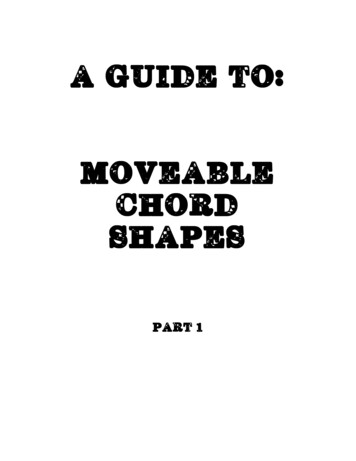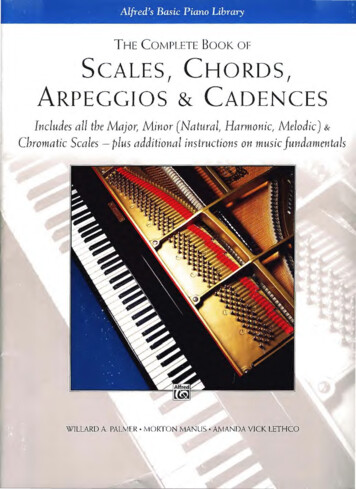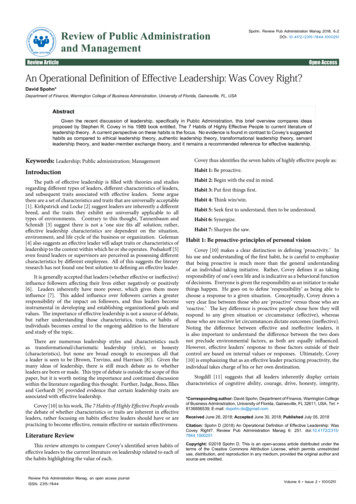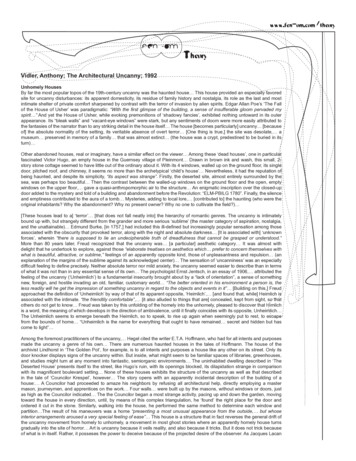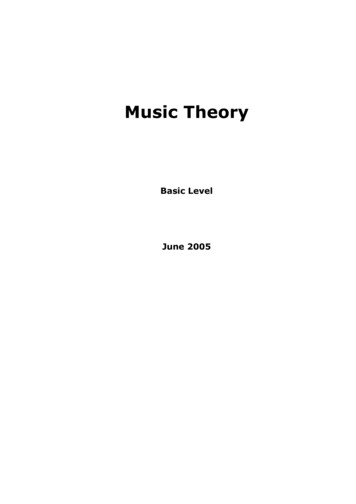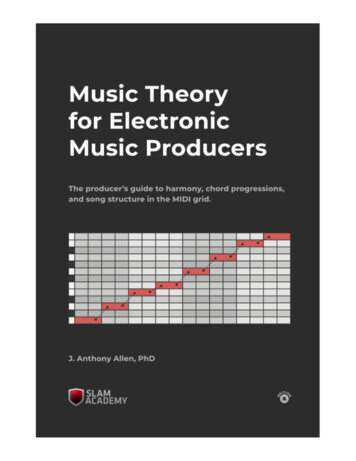
Transcription
Triads and Topos TheoryPadraic Bartlett – VIGRE REU 2007August 20, 20071AbstractThis paper describes how to use topos theory to analyze pieces of music.Specifically, it aims to do the following things: discuss the reasons for studying the topos SetsT , the category of setsequipped with an action by the monoid T of affine maps on Z/12Zpreserving the C-major triad, define a family of 144 affine T-actions µ[m, n] in SetsT that naturallyarises from the structure of T. describe the subobject classifier for SetsT , calculate the Lawvere-Tierney topologies for SetsT , and show how we use the above concepts to comprehend pieces ofmusic.2AcknowledgmentsThis paper was made possible by the financial support of the University ofChicago VIGRE program, the invaluable assistance of my advisor ThomasFiore and my graduate student mentor John Lind, as well as the valiantadministrative efforts of Peter May.33.1IntroductionWhy Does Music Theory use Mathematics?Music theory is a field of study which analyzes the style and mechanics ofmusic. A central concern of music theory is locating patterns in pieces ofmusic and providing a system in which listeners can acquire a better understanding for a piece of music, and in which they can describe this method ofcomprehension to others. Mathematics is a natural tool to apply to this field1
of music theory, as it gives us a set of analytical tools with which to studyboth local and global patterns that arise in a piece of music. Examples offields of music theory which use mathematics are set theory, which breakspieces of music into small cells of notes that “reoccur” throughout the piecein different guises, and transformation theory, which seeks to study whichtransformations – e.g. inversion or transposition by 5 – are central to a pieceof music.In this paper, we will explore the topos of triads SetsT of triads andshow how this sophisticated object can lead to some deep music-theoreticalinsights, by recreating and expanding on Thomas Noll’s study of Scriabin’sEtude Op. 65, No. 3.3.2Why SetsT ?In the first half of our paper, we aim to prove that the monoid T of affinemaps preserving the C-major triad is of definite mathematical interest, andthat it has mathematical properties unique to it which make it an objectthat merits further study (aside from its musical relevance.) Once we havesuch a collection of functions on sets, it then seems natural to study itspossible actions on sets; from there, we will examine the category of all suchT-sets, with objects all T-actions and morphisms T-equivariant functions,which turns out to be a topos.3.3Why Topos Theory?The topos structure of SetsT requires that SetsT has all finite limits, iscartesian closed, has a subobject classifier. In this paper, we focus mainly onthe third property, the subobject classifier – a tool which gives us a notionof a “characteristic morphism” in the category of SetsT , and thus a newway of studying pieces of music by using characteristic functions idiomaticto those pieces to analyze their musical structure.Before this abstraction, however, we begin with some basic music theoryand motivation for why T is an interesting mathematical object to study.44.1Motivating Our Choice of TMusic Theory EssentialsDefinition 1. A pitch class is an equivalence class of pitches, with twopitches regarded as equivalent if they differ by a whole number of octaves.By restricting to the pitch classes which correspond to musical notes (i.e.C, D[ ) we have a set of 12 objects, each corresponding to a different classof pitches. These pitch classes can be thought of as the commutative ringZ/12Z in two distinct ways: using either the semitone encoding,2
0C1C]2D3E[Semitone encoding4 5678]E F FG A[9A10B[11Bwhich orders the pitch classes by the increasing frequency of their representatives within one octave, or the circle of fifths encoding,0C1G2DCircle of Fifths encoding3 4 56789A E B F ] D[ A[ E[10B[11Fwhich begins with the pitch class C and continually advances by a perfect fifth. In this paper, we follow Noll’s work and use the circle of fifthsencoding.Definition 2. An interval1 is an ordered pair (a, b) of pitch classes , a, b Z/12Z.Definition 3. A triad consists of an unordered set {a, b, c} of three distinctpitch classes a, b, c Z/12Z.Definition 4. A interval (a, b) is called consonant if the distance from ato b is a unison, octave, perfect fifth, a major or minor third, or a majoror minor sixth: under the semitone encoding, this means b a lies in theset {0, 7, 3, 4, 8, 9}. An interval that is not consonant is termed dissonant:the intervals that fall in this category are major and minor seconds, majorand minor sevenths, perfect fourths, and the tritone, i.e. those (a, b) withb a {1, 2, 5, 6, 10, 11} under the semitone encoding.It bears noting that this is not a completely universal definition: forexample, the perfect fourth is often regarded as a consonant interval inpractice in certain contexts, i.e. when it is being supported by a perfectfifth. But as an isolated interval, it is generally regarded as dissonant, andwe will do so for the entirety of this paper.4.2Tone Perspectives and Prime FormUnder the encoding above, we have a method of looking at musical notes ina mathematical context as elements of Z/12Z. This allows us to define theconcept of an affine map on musical notes, and the notion of affine mapswhich “preserve” a given musical substructure; mathematical objects thatwe will use (after some abstraction) to study recurrent patterns in Scriabin’sOp. 65 No. 3.1Though this is not the typical notion of interval, it is the one that Noll uses in hispaper, and which we will use here.3
Definition 5. A tone perspective is an affine map f : Z/12Z Z/12Z,i.e. f is of the form f (x) t s · x. We denote such maps by t s, and callthe collection of all such maps A.It bears noting that this collection forms a monoid2 by defining the0product of two tone perspectives as the composition of their maps t s t s0 0t s·t s · s0 .Proposition 1. A tone perspective is determined by where it sends theelements 0 and 1; in fact, there is a bijection between (Z/12Z)2 and A,given by the map t s 7 (t s(0), t s(1)) (t, s t).Proof. For a given tone perspective t s, note that t s(0) t and t s(1) t s,so from the values t s takes on 0 and 1, we can determine the coefficients oft s by settingt t s(0) and s t s(1) t s(0)Corollary 1. There are 144 tone perspectives.Proposition 2. A tone perspective t s is invertible if and only if s {1, 5,7, 11}.Proof. For t s a tone perspective: if s {1, 5, 7, 11}, then note that s 1 Z/12Z, so 1 1 ts 1 1 ts s ts ts s 1 s 0 1,andt 1s ts s 1 t t s 1 s 0 1.0Conversely, if s / {1, 5, 7, 11}, then @s 1 Z/12Z, so for any other t s0 ,t0 000s t s t ts s0 s 6 0 1.So no inverse can exist.Corollary 2. The group of invertible tone perspectives has 48 elements.Definition 6. The T /I group is the group of tone perspectives of the formt s, with t Z/12Z and s {1, 1}.Definition 7. A triad is said to be in prime form3 if it is of the form{0, a, a b}, where 0 a b 12 a b.Example 1. {0, 1, 4} is in prime form, as 0 1 3 8; conversely,{0, 1, 10} is not in prime form, as 0 1 9 2.2A monoid is a set equipped with an associative and unital product.See Richard Cohn’s paper on Neo-Riemannian Operations in the bibliography formore.34
Proposition 3. Every triad is isomorphic to a triad in prime form via amap in the T /I-group.Proof. For a given triad T {x, y, z}, we can get the set of T ’s differences,{y x, z y, x z}. Now, in this set, we have one of two possibilities: either there is an ascending chain y x z y x z, z y x z y x, x z y x z y, or there is a descending chain y x z y x z, z y x z y x, x z y x z y.If we have an ascending chain, then we simply reorder the elements of Tinto the new ordered triad T 0 so that we have the specific ascending chainy x z y x z. Translation by x then yields a triad in prime form,as we get a triad of the form {0, y x, z x} where0 y x,y x z y (z x) (y x), and(z x) (y x) z y x z 12 (z x).Conversely, if we have a descending chain, we apply the inversion mapto T to get the new triad T 0 { x, y, z}; if T had a descending chain,T 0 has an ascending chain as multiplication by -1 reverses the inequalities.So we are done by the above proof.Corollary 3. The following is a complete list of T/I-classes of triads.{0, 1, 2}{0, 1, 3}{0, 1, 4}{0, 1, 5}{0, 1, 6}{0, 2, 4}{0, 2, 5}{0, 2, 6}{0, 2, 7}{0, 3, 6}{0, 3, 7}{0, 4, 8}Definition 8. To any given triad X {a, b, c}, we assign the monoid TXconsisting of all tone perspectives t s such that t s(X) X; thus, TX isthe monoid of all tone perspectives preserving X. We call TX the triadicmonoid associated to X; when we discuss the triadic monoid associatedto the C-major triad {0, 1, 4}, we will often omit the subscript and just writeT, and refer to T as the triadic monoid.4.3Chart of Triadic MonoidsT{0,1,2}T{0,1,3}T{0,1,4}T{0,1,5}T{0,1,6}: {0 0, 0 1, 1 0, 2 11, 2 0}: {0 0, 0 1, 1 0, 3 0}: {0 0, 0 1, 0 4, 1 0, 1 3, 4 8, 4 9, 4 0}: {0 0, 0 1, 0 5, 1 0, 5 0}: {0 0, 0 1, 0 6, 1 0, 6 6, 6 7, 6 0}5
T{0,2,4}T{0,2,6}T{0,3,6}T{0,4,8}: {0 0, 0 6, 0 1, 0 7, 2 0, 2 6, 4 5, 4 11, 4 0, 4 6}: {0 0, 0 6, 0 1, 0 7, 0 3, 0 9, 2 0, 2 6, 2 2, 2 8, 6 3, 6 9, 6 4, 6 10, 6 0, 6 6}: {0 0, 0 1, 0 2, 0 4, 0 5, 0 6, 0 8, 0 9, 0 10, 3 0, 3 4, 3 8, 6 0, 6 2, 6 3, 6 4, 6 6, 6 7, 6 8, 6 10, 6 11}: {0 k, 4 l, 8 m : k, l, m Z/12Z}We omit the monoids for {0, 2, 5}, {0, 2, 7}, {0, 3, 7} here for reasons wewill demonstrate in the next subsection.4.4Examining Noll’s Claim of the Uniqueness of {0, 1, 4}Musically, the major and minor chords are decidedly objects of interest:however, the mathematical justification for why we would want to studySetsT is not necessarily obvious. In his paper, Thomas Noll conjectures thata mathematical property unique to the C-major triad is that it consists of “aconcord of its consonant internal intervals in the sense that their perspectivalextrapolations constitute its self-perspectives” – i.e. under the bijection inProp. 1, the elements of the triadic monoid T correspond to the set of consonant intervals generated by its elements ((0, 0), (0, 1), (0, 4), (1, 0). Nollthen uses this characterization to motivate a study of T and sets equippedwith a T-action.But does this property elegantly generalize from the C-major chord toall of the major chords? Indeed, to any chord that has a triadic monoidisomorphic to T? We categorize all of the triadic monoids below in an effortto answer these questions.Proposition 4. If f : X X 0 is an affine isomorphism of triads, thenTX 0 f TX f 1 .Proof. Let g TX . Then for any f (x) X 0 ,f g f 1 (f (x)) f (g(x)) X 0 f g f 1 TX 0 TX 0 f TX f 1Conversely, let h TX 0 ; then x X,h f (x) X 0 f 1 h f (x) X f 1 h f TX TX 0 f TX f 1 .Given this proposition and the corollary from the earlier subsection onprime form, we only have at most 12 possible distinct triadic monoids; below,we show that there are exactly 8 non-isomorphic triadic monoids.6
Proposition 5. The following is a complete list of those monoids which canoccur as a triadic ,2,6}T{0,3,6}T{0,4,8}Proof. By corollary 3, it suffices to check only the ,8} .By composing 5 0 with 1 7, we can send {0, 1, 4} to {0, 3, 7}; similarly,sends {0, 2, 5} to {0, 1, 3} and 0 7 sends {0, 1, 2} to {0, 2, 7}. Also, byexamining the actual monoids11 07T{0,1,2} {0 0, 0 1, 1 0, 2 11, 2 0}, T{0,1,5} {0 0, 0 1, 0 5, 1 0, 50 },we can see that these are also isomorphic (though not via conjugation byan affine transformation of Z/12Z) via the map 0 5 7 2 11, 1 0 7 0 0, 0 0 7 1 0from the generators of T{0,1,2} to the generators of T{0,1,5} .None of the remaining 8 monoids are isomorphic, as they are all of different cardinalities (see the chart in the earlier subsection for an explicitdescription of all such monoids.)Finally, we make a few brief observations on consonance before studyingthe possible interpretations of Noll’s statement:Proposition 6. Let (a, b) Z/12Z. Then, the following properties of (a, b)hold: The consonance or dissonance of (a, b) is invariant under translation. If b a {0, 3, 4, 8, 9}, then (a, b) remains consonant under any affineautomorphism of Z/12Z. If b a 1, then (a, b) becomes dissonant under inversion, multiplication by 5 or by 7. If b a 11, (a, b) becomes consonant under inversion; under anyother affine automorphism, it remains dissonant. If b a 7, (a, b) becomes consonant under multiplication by 7; underany other affine automorphism, it remains dissonant. If b a 5, (a, b) becomes consonant under multiplication by 5; underany other affine automorphism, it remains dissonant.7
If b a {2, 6, 10}, then (a, b) remains dissonant under any affineautomorphism of Z/12Z.Proof. For any interval (a, b) and a translation (a x, b x), b a b x a x, so (a, b) is consonant if and only if (a x, b x) is.For b a 1, we have that a b 11, 5a 5b 5 and 7a 7b 7;so (a, b) in this case becomes dissonant under inversion, multiplication by 5and multiplication by 7.The other cases are similar, and are left as an exercise.Now we have the mathematical background to properly explore any ofthe possible implications of Noll’s statement. If we read his statement literally, we get that a characterization of the C-major chord is that there is abijection between T and the set of consonant intervals generated by the elements of {0, 1, 4}, {(0, 0), (0, 1), (0, 4), (1, 1), (1, 4), (4, 0), (4, 1), (4, 4)}, givenby t s (t, s t). This characterization is not unique to the C-major chord:there are chords like {1, 2, 10}, the G-minor chord, and F ] -major {6, 7, 10},that share this property. This does not surprise us though, as we expectother major and minor chords to have similar properties. However, not allmajor and minor chords have this property! For example, the A[ -majorchord {0, 8, 9} has 8 8 as an element in its associated triadic monoid, but(8, 8 8) is not an interval contained in the A[ chord. So this property doesnot suffice to characterize either the major chords or the chords with triadicmonoids isomorphic to T.But what if we weaken this criterion? There are two natural directionsin which we could alter our statement: either we require only that there is some bijection between the set T andthe set of consonant intervals generated by a triad, or we require only that the map t s (t, s t) takes each element of Tto some consonant interval.Proposition 7. The major and minor triads and the suspended secondchord – i.e. all chords of the forms {0, 1, 4}, {0, 3, 4} and {0, 1, 2} – arethe unique triads X (up to translation) such that there is a bijection betweenTX and the set of consonant intervals generated by that triad X.Proof. By proposition 5 and the explicit calculations on the chart in section8, we have a complete characterization of all of the distinct triadic monoids.As there are at most 9 consonant intervals possible for any given triad, wecan thus quickly eliminate half of the remaining triads as they all have toomany elements in their triadic monoids, leaving us with{0, 1, 2}, {0, 1, 3}, {0, 1, 4}, {0, 1, 5}, {0, 1, 6}.8
and their associated chords reached by translation and multiplication by 5or 7. (We check {0, 1, 5} here because while it is isomorphic to {0, 1, 2}, it isnot conjugate-isomorphic to it, and some of our techniques will rely on thisproperty.) It thus suffices to check by hand these five cases.So. From the chart earlier, T{0,1,3} 4, but by the consonance observations above, under any automorphism the number of consonant intervalswill be at least 5, as (0, 0), (1, 1), (3, 3)(0, 3), (3, 0) are all invariant underany automorphism of Z/12Z. So there cannot be any such association between {0, 1, 3}’s intervals {or any associated triad} and its associated triadicmonoid. Similarly, T{0,1,6} 7, but by the consonance observations above,under any automorphism the number of consonant intervals will be at most6, as (0, 6) and (6, 0) are dissonant under any automorphism of Z/12Z. Sothere also cannot be any such association between {0, 1, 6}’s intervals andits associated triadic monoid. As well, for {0, 1, 5}, T{0,1,5} 5; but theintervals (0, 0), (1, 1), (5, 5), (1, 5), (5, 1) will all remain consonant under anyaffine isomorphism, while (0, 1) is consonant under inversion, (0, 5) becomesconsonant under multiplication by 5, and (5, 0) becomes consonant undermultiplication by 7. So under any transformation there are at least 6 consonant intervals in any triad with triadic monoid T{0,1,5} , and thus thosetriads also fail to satisfy our condition.For {0, 1, 2}, there are precisely 5 consonant intervals {(0, 0), (0, 1), (1, 1),(1, 2), (2, 2)} and 5 tone perspectives fixing the triad, {0 0, 0 1, 1 0, 2 11, 2 0}, sosuch a correspondence exists for this specific triad: however, multiplicationby 5,7 or 11 will decrease the number of such consonant intervals, as aperfect fifth becomes a dissonant interval under any non-translation affineisomorphism.{0, 1, 4} has a similar correspondence between its consonant intervals{(0, 0), (0, 1), (0, 4), (1, 1), (1, 4), (4, 0), (4, 1), (4, 4)} and its tone perspectives{0 0, 0 1, 0 4, 1 0, 1 3, 4 8, 4 9, 4 0}: also, the number of consonant intervals for thistriad is constant under inversion, as the perfect fifth (0, 1) which becomesdissonant is balanced out by the perfect fourth (1, 0) which becomes consonant. Under multiplication by 5 or 7, however, this doesn’t occur, sotranslations of (0, 1, 4) and the inversion of (0, 1, 4), the minor chord (0, 3, 4)are the only triads associated to T{0,1,4} that have a 1-1 correspondencebetween their consonant intervals and this triadic monoid.Proposition 8. The major triad {0, 1, 4} and the triad {0, 1, 3} are the onlytwo triads up to affine isomorphism such that the interval associated to anytone perspective in their triadic monoid via the mapts (t, t s)is consonant.Proof. From proposition 4, we have that the image of a tone perspective t sunder conjugation by a translation map is (t (s 1)·x) s, under conjugation by9
multiplication by 5 is 5t s, and under conjugation by multiplication by 7 is7t s; so in every case we have that, ass t t (t (s 2) · x) (t (s 1) · x) 5t s 5t 7t s 7t s,if every tone perspective in a given triadic monoid T has a consonant intervalassociated to it by the map t s (t, s t), then all of the triadic monoids T also have this property. So it suffices to check our nine cases: examiningthe earlier chart shows that exactly 2 triadic monoids satisfy this property,namely those associated to the triads {0, 1, 4} and {0, 1, 3}.So neither condition suffices to characterize the major and minor triads;and, while applying both criterion will suffice to uniquely characterize themajor and minor triads, the property of having one bijection between thetriadic monoid T and the set of consonant intervals generated by the triadand a second bijection between T and consonant intervals generated by T’stone perspectives seems rather stretched and less natural than Noll’s initialdescription of the relation. A stronger mathematical reason is desired; luckily, one lies unstated but strongly implied in Noll’s later work, which willeven serve to motivate our next direction of study.55.1T-actions on Z/12Z: Why and HowChart of Generators of Triadic ,2,4}T{0,2,6}T{0,3,6}T{0,4,8}5.2: {0 0, 2 11, 1 0}: {0 0, 1 0, 3 0}: {1 3, 4 8}: {0 0, 0 5, 1 0}: {1 0, 6 6, 6 7}: {0 0, 2 6, 4 5, 4 11, 4 6}: {0 7, 0 3, 2 2, 6 3, 6 9}: {0 2, 0 5, 0 9, 3 8, 6 7}: {0 2, 0 5, 0 7, 0 3, 4 1, 8 1}The Minimality of T{0,1,4}Without deciding what triadic monoid T we wish to study SetsT in relationto, we can still ask ourselves “Which specific sets equipped with T-actionsare going to be objects of interest?” Intuitively, we would want these T-setsto somehow mirror the musical structure of the triadic monoid T – i.e. thatthese sets would consist of subsets of Z/12Z which T would act by affinemaps on. To define any such action for a given triadic monoid T, it sufficesto determine which maps the generators of T get sent to, and thus to make10
choices for the following elements depending on our specific triadic monoid.So how many such maps exist?If we choose to look at the specific T-actions defined on the generators0of T by t s · x t s(x), for any t0 , we then have 123 possible actions ofinterest for every monoid not T{0,1,4} , and in the case of at least half of themonoids, quite a few more, as we can send each generating element to 12other tone perspectives. As T{0,1,4} is generated by just 2 elements, however,it has a comparatively small and easily understood family of 144 such affineactions. This “minimality” is a characteristic that uniquely characterizesthe family of triads affine isomorphic to the C-major chord, as they are theunique triads with associated triadic monoids generated by 2 elements:furthermore, this mathematical property serves to motivate our next areaof study, the collection of all 144 such T-actions.Definition 9. We define µ[m, n] : T Z/12Z Z/12Z as the affine Taction such that µ[m, n](1 3, x) m 3(x) and µ[m, n](4 8, x) m 8(x). (We donot define this action on the other elements of T, as we have already definedit on T’s generators.)Example 2. The natural action of T on Z/12Z, t s · x t sx, is just µ[1, 4]under this notation.Definition 10. For an T-action µ, µ denotes the underlying set of µ.Definition 11. For a given action µ, a subaction ν of µ is a subset ν µ equipped with the same action as µ, closed under this action.Given this notion, a natural question arises: what triads can be expressedas subactions of some µ[m, n], and which triads can be expressed as minimalsubactions (under the ordering of inclusion)?Proposition 9. There are precisely 2 triads (up to affine transformation)that are minimal (under inclusion) subactions of some µ[m, n]: {0, 1, 4} and{0, 2, 6}, the C-major triad {C, E, G} for µ[1, 4] and the “stretched” triad{D, F ] , C} for µ[6, 2].Proof. Note first that any triads affine isomorphic to {0, 1, 2}, {0, 1, 3},{0, 1, 5}, {0, 1, 6}, {0, 2, 4} are not preserved by any tone perspectives t sfor s {3, 8}, and so no µ[m, n] action can preserve these triads.Conversely, to tell if a given triad can be fixed by some µ[m, n], it sufficesto check all of the µ[m, n] such that m 3 and n 8 are in its triadic monoid: so,1. to see if {0, 1, 4} can be described as a minimal subaction of someµ[m, n], it suffices to check if it is a minimal subaction of µ[1, 4],2. to see if {0, 2, 6} is a minimal subaction, it suffices to check µ[6, 2] orµ[0, 2],11
3. to see if {0, 3, 6} is a minimal subaction, it suffices to check µ[6, 6] orµ[6, 3], and finally4. to see if {0, 4, 8} is a minimal subaction, it suffices to check µ[a, b], fora, b {0, 4, 8}.Checking these results by simple calculations {omitted here} gives usthat the triads {0, 1, 4} and {0, 2, 6} are the unique triads that can be expressed as minimal subactions of some µ[m, n], as all of the possible µ[m, n]for {0, 3, 6} and {0, 4, 8} have minimal subactions of only 1 or 2 elements.SetsT as a Topos66.1Definition of a ToposDefinition 12. An elementary topos, or simply a topos, is a categoryE with the following three properties: E has all finite limits. E has a subobject classifier. E is cartesian closed.As stated before, we are going to focus on the subobject classifier inSetsT , which we define below.Definition 13. A subobject classifier is an object Ω and a morphismi : Ω, a terminal object, such that for any objects A, X and amonomorphism f : A X, there is a unique arrow χA such the square/ Afi XχA /Ωis a pullback square.To illuminate what’s going on, we use the example topos Sets, whereSets is the category with objects all sets and arrows all functions betweensets.Proposition 10. The subobject classifier of Sets is the function i : {1} {0, 1}, i(1) 1.12
Proof. This means that for any sets A, X with an injection of A into X,there must be a unique function χA such that the diagram/ {1}Afi / {0, 1} XχAis a pullback square.In the case of Sets, this unique function is the characteristic functionof A, as we show here: because χA (A) {1}, we have that the squarecommutes. Also, for any other function α such that α(A) {1}, if thereexists a x X such that χA (x) 0 and α(x) 1, then the set α 1 (1) withinclusion map g : α 1 (1) X has no map h into A such that the triangleZhAgf Xcommutes.So the function such that the earlier square is a pullback square is unique:therefore, i : {1} {0, 1}, i(1) 1 is the subobject classifier of Sets.Proposition 11. SetsT has a subobject classifier. Namely, it has the subobject classifier i : {T} Ω, with Ω {T, P, L, R, C, F} consisting of all ofthe left ideals of T, with the T-action ω : T Ω Ω, ω(m, B) {t T :t m B}13
T : {0 0, 0 1, 0 4, 1 0, 1 3, 4 0, 4 8, 4 9}OP : {0 0, 0 4, 1 0, 1 3, 4 0, 4 8, 4 VVVVVVVVVhhh3hhhhhhhhhhhhhhhR : {0 0, 0 4, 1 0, 4 0, 4 8}L : {0 0, 1 0, 4 0, 1 3, 4 9}C : {0 0, 1 0, 4 0}OF : { }Proof. To show that our category SetsT has i : {T} Ω as a subobjectclassifier, we must show that for any inclusion f : ν µ , ν a T-subactionof µ, there is a unique pullback square ν t ν f/ {T} i µ χ ν /Ωwhere t ν is the unique map ν T.We know the following things:1. Given that we want this diagram to commute, we need our arrow χ ν to be equivariant under the action of T – i.e. that ( x µ )( t T), t · χ ν (x) χ ν (t · x).2. Also, because this diagram commutes, we have that (as i t ν ( ν ) {T},) χ ν f ( ν ) must be equal to {T}.3. Furthermore, for any Z a T-set with z1 : Z µ such that the squarewith vertex Z commutes, there must be a unique map z2 : Z ν making the diagram below commute, as χ ν makes this square apullback square.14
ZtZz2'/ {T}t ν ν z1fi /ΩχA µ By condition (2), we know that we have to send all of the elements of ν to T. Conversely, if we send any more than these elements to T, wecan create a new set Z χ 1 ν (T) with the inclusion map z1 into µ : then,because this set Z / ν , there is no map z2 that factors through ν andis equal to the inclusion map of Z into µ . So it must send exactly theelements of ν to T, and no others.This then, with the requirement that χ ν is equivariant, forces the following definition:χ ν (x) {h T h · x ν }First, we observe that this is a well-defined function. This is just checkingthat x µ , we have that χ ν (x) is a left ideal; so, taking any g χ ν (x),we observe that h T, (h · g) · x h · (g · x) ν ,because g · x ν and ν is closed under T-actions: and thus that χ ν (x) isclosed under action by T.Second, we note that it trivially commutes, as i t ν ( ν ) χ ν f ( ν ) {T}).Third, we note that this is a pullback square, as for any Z with z1 :Z µ such that the square with vertex Z commutes, we have that, asi tZ χ ν z1 , all of Z is thus mapped to T and thus Z ν : so there isa unique map Z ν , z 7 f 1 (z1 (z)).Finally, we note that this is the unique arrow such that this forms apullback square, as for any other map α such that the following diagramcommutes, ν t ν f/ {T} i µ χ ν α15 /Ω
we have that α and χ ν agree on ν α 1 (T) χ 1 ν (T) because the squarecommutes.As well, x µ , we have that( h T) s.t. (h · x ν ), h · α(x) α(h · x) T.For such a h, h / α(x) h · α(x) 6 T by the multiplication table below; so h T s.t. h · x ν , h α(x). So α(x) χ ν RTTCCTTTRRLLFFFFFFFFFTo see the other containment, note that if h α(x) such that h·x / ν ,then we either have α(x) {L, R, P} and χ ν (x) C, in which case action by either 1 3 or4 8 causes α to take on the value T where χ ν does not, a contradiction, or α(x) P and χ ν (x) L, R, C, in which case action by one ofeither 1 3 or 4 8 causes α to take on the value T where χ ν does not, acontradiction.So i : {T} Ω is a subobject classifier.7Possible Subobjects and the Lawvere-TierneyTopologiesSo what can we do with this subobject classifier? We want to get an understanding of the underlying shape of the musical objects we study; thus, wecan look for the Lawvere-Tierney topologies with respect to our subobjectclassifier, and examine how we can apply these arrows to pieces of music.Intuitively, a Lawvere-Tierney topology is a way to define a sort of “topology” on a topos. For the purposes of studying SetsT , we will use them todetermine which of the subobjects above are “characterizing” in some wayour topos, and apply these maps to analyze pieces of music.Definition 14. A Lawvere-Tierney topology on a topos E is a mapj : Ω Ω such that the following three properties hold:16
1. j T T2. j j j3. j (j j),where : Ω Ω Ω is the intersection mapTo find the Lawvere-Tierney topologies, we must first define how T actson Ω; with that done, we simply find all of the possible subobjects of Ω andcheck which characteristic arrows satisfy the axioms to be Lawvere-Tierneytopologies.Definition 15. T acts on Ω by left composition: i.e. given a left ideal X ofΩ and an element t T, we define t · X as {t x : x X}.Proposition 12. Under the action of T on Ω, the subobject classifier ofSetsT , there are 22 possible subobjects of Ω.Proof. Pick s
elds of music theory which use mathematics are set theory, which breaks pieces of music into small cells of notes that \reoccur" throughout the piece in di erent guises, and transformation theory, which seeks to study which transformations { e.g. inversion
